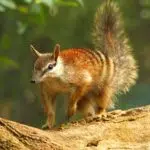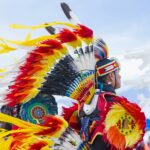You see them everywhere — on coins, on sports team logos, and a couple of state flags. No, we’re not talking about the bald eagle. This honor is reserved for North American bison. On National Bison Day, November 1, an annual event that falls on the first Saturday in November, all Americans should reflect on the impact bison have as a part of our environmental and cultural heritage. Bison are especially revered by Native people — central to their survival as both food and spiritual inspiration.
National Bison Day timeline
Hunting dramatically reduced the population — leaving a mere 700 in private herds; even Yellowstone was left with only 23 bison by 1902.
The InterTribal Indian Council formed not only to return bison to tribal lands, but also to create culturally-sensitive educational programs and provide both technical resources and help to 56 tribes.
The first conservation agreement between an environmental organization and a diverse collective of Native American tribes agreed to combine efforts to return wild bison to tribal land.
The Senate passed its first resolution honoring National Bison Day, which was also supported by various tribal groups and the Wildlife Conservation Society.
How to Observe National Bison Day
Sign a petition
Stand in support of returning wild bison to their original tribal lands on thousands of acres of Native American reservations. Collaborations among certain groups are working to remind Americans about the important role bison play in the lives of native peoples. Bison are considered sacred and they are even featured in certain tribal creation stories. Bison have also been a source of food and clothing — providing hides for tents, robes, shoes, and tools so that people could survive in harsh climates.
Visit a national park
You may not be able to get to a large national park like Yellowstone, but there are a vast number of smaller parks from which to choose. Imagine what it must have been like to see thousands of bison freely roaming the plains. Give your children a chance to experience the wonder of our latest national icon — the bison.
Wear your National Bison Day T-shirt
Many groups use this day to raise funds in support of bison. It won’t be hard to find a T-shirt showing your love of bison. Wear it proudly because it’s for a great, patriotic cause.
5 Reasons We Love Our Bison
Watch that tail
If a bison’s tail is hanging down and moves naturally from side to side, the animal is relaxed. But when the tail stands straight up, it's a signal the bison is getting ready to charge.
They've got skills
Given their size as the largest mammals in North America, bison are surprisingly agile with an ability to swim well, jump up to six feet, and run between 35 and 40 mph.
They're oldies but goodies
Bison have always roamed in Yellowstone National Park as evidenced by prehistoric fossils found in modern times.
Throw a stone — hit a bison
Herds of bison can be found in all 50 states.
Bison as symbols
The American bison is not only the country's official mammal; the bison is also the state mammal of Wyoming, Oklahoma, and Kansas.
Why National Bison Day is Important
It's our national mammal
President Obama, with the support of a broad coalition of Native American tribes, wildlife support groups, and concerned members of the Senate, signed a 2015 law making the proud and majestic bison our national mammal. This law helps to protect bison from extinction and encourages a return back to their native tribal lands.
They're different from buffalo
We know you have been wondering about this so we're going to set you straight. Bison and buffalo are not the same. Bison are native to North and South America and Europe, while the traditional home of the buffalo is in Africa and Asia. At the height of their magnificence, there were between 30 and 60 million bison in the New World circa the 16th century. Today, there are currently half a million bison roaming happily across North America. .
They were almost extinct
Native peoples once lived their lives around the vast herds of bison that swirled around areas of the west and northwest, the central plains, and the southeastern U.S. Once pioneers started their westward trek, both the Native American tribes and the bison herds were seen as obstacles to progress. As the native peoples were systematically forced off their lands by either poachers or fake government treaties, the bison herds began to disappear; by the early part of last century, bison were on the way to extinction. Today, through the collective efforts of Indian tribes, wildlife associations, the national park system and others, bison have re-emerged as a protected species.
National Bison Day dates
| Year | Date | Day |
|---|---|---|
| 2024 | November 2 | Saturday |
| 2025 | November 1 | Saturday |






















































































